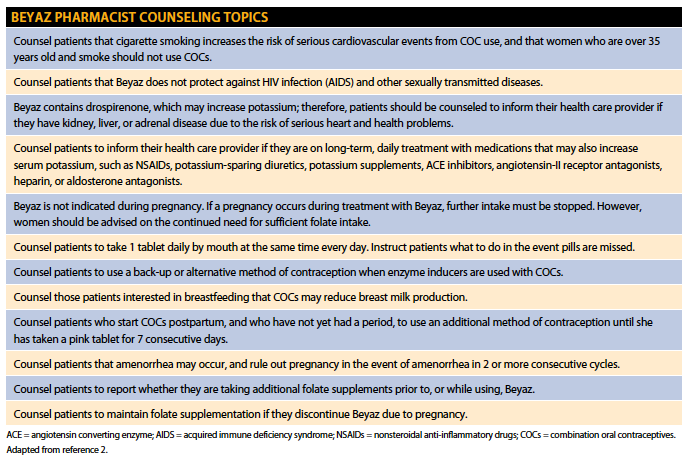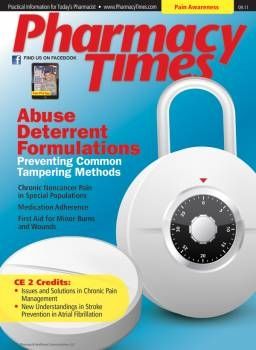Publication
Article
Pharmacy Times
Opportunities with a 24-4 Day Combination Oral Contraceptive Containing Folate
Financial and editorial support provided by

INTRODUCTION
The neural tube is a structure that develops into the brain and spinal cord during embryonic development. Failure of the neural tube to close during pregnancy may result in spina bifida or anencephaly, which are serious neural tube defects (NTDs) affecting the spine and brain, respectively. These birth defects occur in early pregnancy, often before the woman realizes she is pregnant.1 The potential to reduce the incidence of NTDs with folate supplementation is well established based on a body of evidence derived from randomized, controlled trials, nonrandomized intervention trials, and observational studies using folic acid.2
From 1995 to 1996, the prevalence rates (per 10,000 live births) for spina bifida and anencephaly in the United States were estimated to be 5.04 and 2.60, respectively.3 In January 1998, mandatory folic acid fortification of enriched cereal grain products went into effect.1 From 1998 to 2006 (post-fortification), the prevalence rates declined approximately 31% to 3.49 for spina bifida and 30% to 1.82 for anencephaly.3 These estimates are based on 27 population-based birth defects surveillance systems in the United States, and included programs with and without prenatal ascertainment. To further reduce the risk of NTDs, the US Preventive Services Task Force (USPSTF) recommends that all women of childbearing potential consume at least 400 mcg of supplemental folic acid daily.4 It is important, however, to inform patients that NTD risk may not be completely eliminated, even if they obtain the recommended amount of folate before and during pregnancy.
UNINTENDED PREGNANCY, FOLIC ACID CONSUMPTION, AND THE NTD CONNECTION
In 2001, nearly half (49%) of pregnancies in the United States were unintended.5 Of unintended pregnancies in 2001, 48% were conceived during a month in which contraceptives (including, but not limited to oral contraceptives) were used.5
The results of a survey on women’s knowledge and use of folic acid conducted by Gallup were published by the March of Dimes Foundation in 2008. The survey was a nationally representative telephone survey targeting 2003 English-speaking women.6 Questions asked included “Do you currently take any vitamin or mineral supplements on a daily basis?” and “What type of vitamin or mineral supplements do you take?”6 The margin of error was ±3%.6 The survey showed that 39% of women of childbearing age (aged 18 to 45 years) reported taking a daily vitamin containing folic acid.6 The percentage of women who reported taking a daily vitamin containing folic acid was highest among women aged 35 to 45 years (44%) and lowest in women aged 18 to 24 years (27%); of women aged 25 to 34 years, 41% reported taking a vitamin containing folic acid daily.
Several approaches to enhancing folic acid consumption have been suggested by the US Public Health Service, including improving dietary habits, fortifying foods with folic acid, and taking folic acid-containing supplements.1
COMBINATION ORAL CONTRACEPTIVE CONTAINING FOLATE
In December 2003, a meeting of the FDA Advisory Committee for Reproductive Health Drugs was convened to discuss the public health issues, including safety and potential clinical benefit, of an oral contraceptive/folic acid combination product for women of childbearing potential. The goal was to reach women of childbearing potential either who currently take an oral contraceptive and conceive while on the oral contraceptive, or who discontinue the oral contraceptive and immediately conceive.7
The committee members voted unanimously (18 to 0) that further increases in folic acid intake, beyond what is achieved via consumption of fortified cereal grain products, are likely to result in public health advances in preventing NTDs.7 There was also unanimous agreement that an oral contraceptive was a reasonable delivery vehicle for the provision of additional folic acid, and that a daily dose of 400 mcg was a “reasonable dose.”7 If taken every day as directed, such a formulation ensures daily consumption of folic acid as part of the oral contraceptive regimen.
ABOUT BEYAZ®
Beyaz (drospirenone/ethinyl estradiol/levomefolate calcium tablets and levomefolate calcium tablets) is a combination oral contraceptive (COC) that consists of 28 tablets: the 24 pink tablets contain drospirenone 3 mg, ethinyl estradiol 0.02 mg, and levomefolate calcium 0.451 mg, whereas the 4 light orange tablets contain levomefolate calcium 0.451 mg.2 Levomefolate calcium 0.451 mg is an equimolar dose to folic acid 0.4 mg (400 mcg).2
Beyaz has received FDA approval for 4 indications. Beyaz is indicated to prevent pregnancy.2 Beyaz has 99% contraceptive efficacy when used as directed.2 In women who choose to use a COC as their method of contraception, Beyaz is indicated to raise folate levels for the purpose of reducing the risk of an NTD in a pregnancy conceived while taking or shortly after discontinuing the product.2 Beyaz is not indicated during pregnancy.2 Plasma folate levels are likely to return to baseline approximately 20 weeks after discontinuation.2 Folates may mask vitamin B12 deficiency.2 Counsel patients to report whether they are taking folate supplements. Ensure that folate supplementation is maintained if a woman discontinues Beyaz.2
Beyaz is also indicated for the treatment of moderate acne vulgaris in women at least 14 years of age who have achieved menarche. Beyaz should be used to treat moderate acne only if the patient desires a COC for birth control. Beyaz is also indicated for the treatment of symptoms of premenstrual dysphoric disorder (PMDD) in women who choose to use a COC as their method of contraception. Beyaz has not been evaluated for treatment of premenstrual syndrome. The effectiveness of Beyaz for PMDD has not been evaluated when used for more than 3 menstrual cycles.2 Please see Beyaz Pharmacist Counseling Topics and Important Safety Information about Beyaz below.
PEARL INDEX
The primary contraceptive efficacy study evaluated a COC containing 3 mg drospirenone/0.02 mg ethinyl estradiol. The study of up to 1 year duration enrolled 1027 subjects who completed 11,480 28-day cycles of use.2 The pregnancy rate (Pearl Index) was 1.41 (95% confidence interval [0.73 — 2.47]) per 100 woman-years of use based on 12 pregnancies that occurred after the onset of treatment and within 14 days after the last dose of this COC in women 35 years of age or younger during cycles in which no other form of contraception was used.2

IMPORTANT SAFETY INFORMATION ABOUT BEYAZ
Patients Who Should Not Take Beyaz
Women over 35 years old who smoke should not use Beyaz. Smoking increases the risk of serious cardiovascular side effects from Beyaz use. This risk increases with age and the number of cigarettes smoked.
Beyaz is contraindicated in women with a high risk of arterial or venous thrombotic diseases, undiagnosed abnormal uterine bleeding, breast cancer or other hormone-sensitive cancer, liver tumors (benign or malignant) or liver disease, conditions that predispose to hyperkalemia (ie, renal impairment, hepatic dysfunction, and adrenal insufficiency), or who are pregnant.
Known Serious Risks With Beyaz
Thromboembolic and other vascular events: Stop Beyaz if an arterial or deep venous thrombotic event occurs. The risk of venous thromboembolism is highest during the first year of use of COCs. COC use also increases risk of arterial thromboses (eg, stroke and myocardial infarction) especially in women with risk factors for these events. Use COCs with caution in women with cardiovascular disease risk factors. If feasible, stop Beyaz at least 4 weeks before and through 2 weeks after major surgery or other surgeries known to have an elevated risk of thromboembolism. Start Beyaz no earlier than 4 weeks after delivery in women not breastfeeding.
Hyperkalemia: Beyaz contains drospirenone that has the potential for hyperkalemia in high-risk patients and is contraindicated in patients with conditions that predispose to hyperkalemia. Check serum potassium level during the first treatment cycle in women who receive long-term treatment with medications that may increase serum potassium (eg, angiotensin converting enzyme [ACE] inhibitors, angiotensin-II receptor antagonists, potassium-sparing diuretics, potassium supplementation, heparin, aldosterone antagonists, and nonsteroidal anti-inflammatory drugs [NSAIDs]).
Liver disease: Discontinue Beyaz if jaundice develops.
High blood pressure (BP): Women with uncontrolled hypertension or hypertension with vascular disease should not use COCs. Monitor BP in women with well-controlled hypertension and stop Beyaz if BP rises significantly. BP may increase in COC users, more likely occurring in older women and with extended use.
Gallbladder disease: Studies suggest a small increased relative risk of developing gallbladder disease among COC users.
Carbohydrate and lipid metabolic effects: Monitor prediabetic and diabetic COC users. Consider alternative contraception for women with uncontrolled dyslipidemia.
Headache: If a Beyaz user develops new headaches that are recurrent, persistent, or severe, evaluate the cause and discontinue Beyaz if indicated.
Bleeding irregularities: Evaluate irregular bleeding or amenorrhea; check for causes such as pregnancy or malignancy.
Folates may mask vitamin B12 deficiency.
Counsel patients that Beyaz does not protect against HIV infection and other sexually transmitted diseases.
Serious adverse reactions in clinical trials:
Cervix carcinoma stage 0, cervical dysplasia, migraine
Most common adverse reactions in clinical trials:
Frequent (≥2%) adverse reactions in contraception, moderate acne and folate clinical trials were: headache/migraine (5.9%), menstrual irregularities (4.1%), nausea/vomiting (3.5%), and breast pain/tenderness (3.2%).
Frequent (≥2%) adverse reactions in PMDD clinical trials were: menstrual irregularities (24.9%), nausea (15.8%), headache (13.0%), breast tenderness (10.5%), fatigue (4.2%), irritability (2.8%), decreased libido (2.8%), increased weight (2.5%), and affect lability (2.1%).
CONCLUSION
Neural tube closure occurs during the first month after conception, often before a woman realizes she is pregnant.2 The potential to reduce the incidence of NTDs with folate supplementation is well established based on a body of evidence derived from randomized, controlled trials, nonrandomized intervention trials, and observational studies using folic acid.3 The USPSTF recommends that all women of childbearing potential consume at least 400 mcg of folic acid daily.5 There are many ways to obtain supplemental folic acid; Beyaz is a COC containing levomefolate calcium that provides one option for women who choose a COC for contraception to obtain supplemental folate for the purpose of reducing the risk of an NTD in a pregnancy conceived while taking or shortly after discontinuing the product.
REFERENCES
- Centers for Disease Control and Prevention. Spina bifida and anencephaly before and after folic acid mandate--United States, 1995-1996 and 1999- 2000. MMWR Morb Mortal Wkly Rep. 2004;53(17):362-365.
- Beyaz [prescribing information]. Wayne, NJ: Bayer HealthCare Pharmaceuticals Inc. 2010.
- National Birth Defects Prevention Network. Neural Tube Defect Ascertainment Project. http://www.nbdpn.org/current/2010pdf/NTD%20fact%20sheet%2001-10%20for%20website.pdf. Accessed August 17, 2011.
- US Preventive Services Task Force. Folic acid for the prevention of neural tube defects: US Preventive Services Task Force recommendation statement. Ann Intern Med. 2009;150(9):626-631.
- Finer LB, Henshaw SK. Disparities in rates of unintended pregnancy in the United States, 1994 and 2001. Perspect Sex Reprod Health. 2006;38(2):90-96.
- March of Dimes Foundation. Improving Preconception Health: Women’s Knowledge and Use of Folic Acid. White Plains, NY; 2008.
- US Food and Drug Administration. Summary minutes, Advisory Committee for Reproductive Health Drugs meeting, December 15, 2003. www.fda.gov/ohrms/dockets/ac/03/minutes/4002M1_Final.pdf. Accessed June 10, 2011.
Please click here to see brief summary of full Prescribing Information about Beyaz, including boxed warning.
Please see www.beyaz.com for full Prescribing Information.








